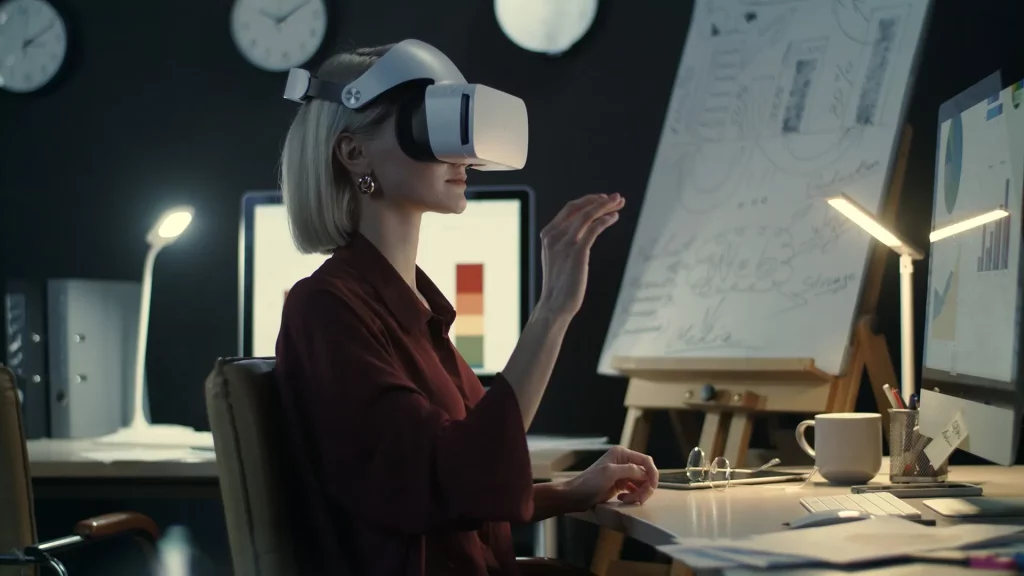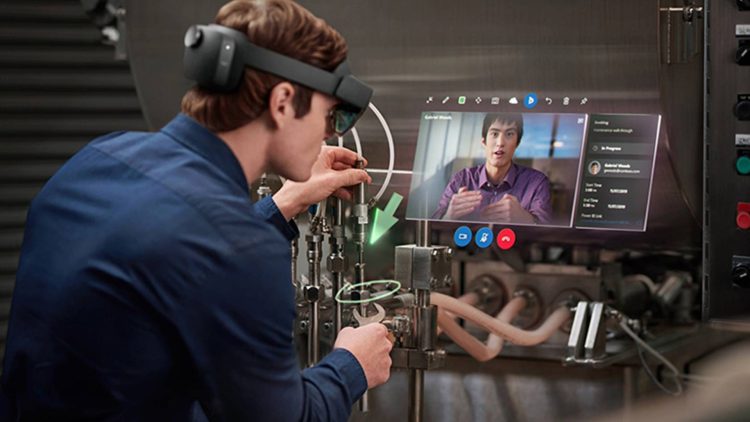Introduction
In recent years, Augmented Reality (AR) and Virtual Reality (VR) have emerged as two of the most groundbreaking technologies that are shaping the way we interact with the world around us. These immersive technologies, once considered futuristic, are now playing an increasingly pivotal role in various industries, from entertainment and gaming to healthcare and education. The rapid advancements in AR and VR technologies have made immersive interaction not only a possibility but a reality for users around the globe.
While Virtual Reality (VR) offers users fully immersive, computer-generated environments, Augmented Reality (AR) overlays digital content onto the real world, enhancing the user’s perception of their physical surroundings. Both technologies, though distinct, share the common goal of enhancing human experience by providing interactive and engaging experiences that go beyond traditional media.
This article delves into the advancements in AR and VR technologies, exploring how they have led to the development of immersive interactions, their applications, challenges, and the potential for the future of immersive experiences. We will also discuss the implications of these technologies on various industries and the everyday user, as well as their influence on the future of human-computer interaction.
1. Understanding Augmented Reality (AR) and Virtual Reality (VR)
1.1 Defining Augmented Reality (AR)
Augmented Reality (AR) is a technology that enhances the physical world by overlaying digital elements—such as images, videos, or sounds—onto a user’s real-time view of their environment. This augmentation allows users to interact with both the physical and digital worlds simultaneously. The key feature of AR is that it does not replace the real world but adds digital information to it.
Some key examples of AR include:
- Mobile apps like Pokemon GO, where users see virtual creatures in real-world locations through their smartphone screens.
- Microsoft’s HoloLens, which superimposes holographic images onto a real-world environment, allowing users to interact with 3D objects as though they were part of the real world.
- Snapchat filters, which place digital effects on a user’s face during live interactions.
1.2 Defining Virtual Reality (VR)
Virtual Reality (VR), on the other hand, involves creating a completely immersive, computer-generated environment that users can interact with, typically through a VR headset. The goal of VR is to replace the real world with a virtual one, providing a fully immersive experience.
Key features of VR technology include:
- 360-degree immersion: Users can look around in any direction within a VR environment, experiencing the virtual world in its entirety.
- Interactive experiences: VR allows users to interact with the virtual world using motion tracking controllers, hand gestures, or even eye movement.
- Applications in gaming and entertainment: VR has become a major player in the entertainment industry, with VR games and experiences offering a new level of interaction.
Popular VR platforms include Oculus Rift, HTC Vive, and PlayStation VR, which offer users a fully immersive experience in virtual worlds.

2. Advancements in AR and VR Technologies
2.1 AR Technology Progressions
Over the past decade, AR technology has made significant strides, particularly due to advancements in smartphones, wearable devices, and optical sensors. These advancements have enabled AR applications to become more accessible and engaging. Some key advancements in AR include:
- Better Hardware: AR’s reliance on mobile devices, smart glasses, and AR headsets has seen major improvements. Apple’s ARKit and Google’s ARCore have empowered developers to create more sophisticated AR experiences on smartphones by enhancing the accuracy of object tracking and environmental mapping.
- Markerless AR: Early AR systems required markers or QR codes to trigger digital content. Today, markerless AR uses advanced computer vision to track real-world surfaces without the need for special markers, making the technology more seamless.
- Wearable AR: The development of smart glasses such as Microsoft’s HoloLens and Magic Leap has been a game changer for AR. These devices offer hands-free interaction with digital elements in real-time, which is especially valuable for professionals in fields such as manufacturing, healthcare, and architecture.
- Improved User Interaction: With the advent of AI-powered object recognition, AR systems are now able to understand complex environments, making it easier for users to interact with their surroundings in a more natural way. Gesture recognition, voice commands, and eye-tracking technologies have enhanced user interaction, making AR systems more intuitive.
2.2 VR Technology Breakthroughs
Similarly, VR has evolved significantly, driven by advances in hardware and software. Early VR systems were bulky and expensive, but recent improvements have made VR more accessible and affordable. Key developments include:
- High-Resolution Displays: Modern VR headsets now feature high-resolution OLED or LCD displays that deliver incredibly realistic visuals. Devices like the Oculus Quest 2 and Valve Index have improved image clarity and reduced the screen door effect (a visual artifact that makes users see grid lines in VR).
- Motion Tracking: VR platforms now use more advanced motion sensors and tracking systems that provide accurate tracking of users’ head, hand, and body movements. This has dramatically improved the realism of VR environments and the ability to interact with virtual objects.
- Wireless VR: The introduction of wireless VR headsets like the Oculus Quest has eliminated the need for PC or console connections, giving users a completely untethered experience. This freedom of movement enhances immersion and makes VR more accessible to a wider audience.
- Haptic Feedback: The incorporation of haptic feedback (vibrations or force feedback) in VR controllers provides users with a more tactile experience, allowing them to “feel” virtual objects. This adds to the realism of VR and enhances the sense of immersion.
- Social VR and Multiplayers: Virtual reality is also evolving in the social domain, with platforms like VRChat and Rec Room offering spaces where users can interact with others in virtual environments, playing games, attending events, or simply socializing.
3. Immersive Interaction in Different Sectors
3.1 AR and VR in Gaming and Entertainment
The entertainment industry has embraced AR and VR to offer immersive gaming experiences that were once impossible. VR gaming, in particular, has exploded in popularity, with immersive experiences becoming the new norm in gaming.
- Virtual Reality Gaming: VR provides a level of immersion that traditional gaming setups cannot. Games like Beat Saber, Half-Life: Alyx, and The Walking Dead: Saints & Sinners offer immersive, action-packed experiences that transport players into entirely new worlds.
- Augmented Reality Gaming: AR games like Pokémon GO blend the digital and physical worlds, encouraging players to explore their real-world environments while interacting with virtual elements. This creates an entirely new way of engaging with games, enhancing the social aspect of gaming.
Beyond gaming, AR and VR are being used in virtual movie experiences, interactive storytelling, and immersive theme park attractions like those in Disney World, offering visitors a completely new way to experience entertainment.
3.2 AR and VR in Education and Training
Both AR and VR have shown immense potential in revolutionizing education by providing immersive learning experiences that engage students in more interactive and effective ways.
- Virtual Reality in Education: VR allows students to immerse themselves in virtual classrooms and simulated environments. For instance, students can visit historical landmarks, explore the human body, or conduct virtual chemistry experiments. VR is used in fields like medical education, where students can practice surgeries in a controlled, risk-free environment.
- Augmented Reality in Education: AR enhances textbooks, classrooms, and educational materials by overlaying interactive content. For example, AR apps allow students to view 3D models of biological organisms or astronomical objects on their smartphones or AR glasses, providing a deeper understanding of complex subjects.
- Simulations and Training: VR is widely used in professional training, including in military, aviation, and medical fields, allowing individuals to practice real-world scenarios in a safe and controlled virtual space. VR is also used for training workers in high-risk industries like oil drilling, mining, and firefighting, where simulated experiences provide realistic but safe training.
3.3 AR and VR in Healthcare
The healthcare sector is benefiting greatly from both AR and VR technologies, improving patient care, treatment, and even the training of medical professionals.
- Virtual Reality Therapy: VR has been used as a therapeutic tool for conditions like PTSD, phobias, and anxiety disorders. By immersing patients in controlled virtual environments, therapists can help patients confront their fears and anxieties in a safe space.
- Surgical Assistance with AR: AR technology is now being used to guide surgeons in real-time, providing them with augmented views of a patient’s anatomy during surgery. AccuVein, for example, helps nurses locate veins by displaying veins on the skin’s surface using AR.
- Rehabilitation: VR is being used for physical and occupational therapy, providing patients with engaging and interactive exercises to aid in recovery. Virtual environments allow patients to perform tasks like walking or gripping objects, which can be tracked and adjusted based on progress.
4. Challenges and Future Directions
4.1 Technical Challenges
Despite the progress in AR and VR technologies, there are still significant challenges to overcome. These include:
- Hardware Limitations: While AR and VR systems have become more affordable, the need for powerful hardware to run these systems (especially for high-end VR) remains a barrier for widespread adoption.
- User Comfort: Issues like motion sickness in VR and the weight or bulkiness of AR glasses continue to hinder the user experience.
- Content Creation: Creating high-quality, interactive AR and VR content can be complex and costly, limiting the variety of available experiences.
4.2 Ethical and Social Implications
With the growing use of AR and VR, concerns regarding privacy, security, and data collection have also surfaced. As these technologies increasingly track users’ movements, behaviors, and even emotions, it’s essential to establish ethical guidelines and privacy protections.
Conclusion
The advancements in Augmented Reality and Virtual Reality technologies have paved the way for truly immersive interactions, transforming how we work, learn, play, and communicate. From immersive gaming experiences and training simulations to virtual healthcare and interactive education, AR and VR are revolutionizing industries and enriching the human experience.
As the technology continues to evolve, we can expect even more seamless and engaging interactions, making the virtual world an integral part of our everyday lives. However, it is crucial to address the technical, ethical, and social challenges to ensure that these technologies are developed and used responsibly. As the boundaries between the physical and virtual worlds continue to blur, the future of immersive interaction promises a new era of human-computer engagement.







































